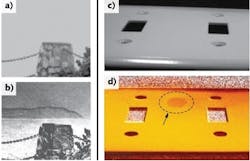NOVEL CAMERAS: Polarization difference imaging camera reveals ‘unseen’ features
Subtle surface details, textures, and entire features missed by an unpolarized white-light camera can be revealed through real-time polarization difference imaging via a novel polarimetric camera architecture, dubbed Detect POL, developed and patented by Q5 Innovations (Victoria, BC, Canada) and built and tested in collaboration with scientists at Université Laval led by Simon Thibault (Quebec, QC, Canada).1
Polarization difference imaging (PDI) technology has been limited by sequential capture of image data—typically at rates much slower than the real-time variation of polarization (POL) information within a scene. Q5 Innovations developed the Detect POL imaging and sensing technologies, including a custom beamsplitting assembly that enables simultaneous, real-time capture of the polarization difference image across a wide field of view, revealing features otherwise “unseen” by conventional cameras (see figure).
Splitting the beams
Even in the presence of fog, clouds, and dust, in underwater scenes, or through other scattering media, POL research shows that even if less than 1% of the returning light from a target has been polarized, the polarization difference method can be highly effective at revealing hidden features, assuming the two orthogonal states of linear polarization data are captured simultaneously. Essentially, in PDI, two images of the same scene are captured at two different planes of linear polarization and then digitally subtracted from each other.
Historically, the use of linear polarization filters to isolate the two discrete planes of polarization information (limiting the intensity and wavelength of the transmitted light) and sequential imaging (not effective for moving objects) have precluded PDI from many real-world applications. But Q5 has adopted a biomimetic approach to carry out PDI at any given wavelength in real time by creating a polarization beamsplitter that mimics the structural-base isolation of orthogonal planes of linear polarized light as seen by the retinal anatomy of sunfish.
The optical design selectively redirects all linearly polarized light of two specific orientations out of a common input, to maximize the amount of light used to form each polarization-specific image and to collect both polarization-specific images simultaneously. This latter feature allows for the real-time comparison and computation of the PDI video stream, with video capture possible at tens of thousands of frames per second.
Future of POL development
The next step is to build the next-generation prototype using custom coatings, electronics, and algorithms developed by Q5 Innovations, and then to adapt the Detect POL technologies to polarization platforms such as thermal, terahertz, and range-gated imaging systems. The detector-agnostic modular approach assists new and existing imaging technologies. For example, when POL data is added to thermal systems, thermal inversion is no longer a concern; adding POL to terahertz-radiation systems has the potential to improve detection of weapons and nontraditional explosive devices under clothing.
POL in combination with range-gating can limit or eliminate scattering effects, enhancing image resolution and signal-to-noise ratio. Polarimetric analysis of the range-gated laser return signal allows for the extraction of information about target geometry, texture, and material properties in addition to traditional intensity and time-of-flight data, aiding in target identification (not just target detection).
“Our research has proven the capability of Detect POL to perform polarization difference imaging in real time, with applications [such] as latent fingerprint analysis, discrimination of moving manmade objects from natural surroundings or in camouflage, to material discrimination,” says Denis Brousseau, a research associate at Université Laval. “However...Detect POL has the potential of disrupting the landscape for imaging across many industries, from its ability to see through turbid water for energy applications as diverse as nuclear decommissioning and downhole oil and gas [operations] to healthcare applications such as early detection of cancer.”
REFERENCE
1. D. Brousseau et al., Workshop on Information Optics (WIO) 2012, poster paper 10, Quebec City, QC, Canada (August 2012).

Gail Overton | Senior Editor (2004-2020)
Gail has more than 30 years of engineering, marketing, product management, and editorial experience in the photonics and optical communications industry. Before joining the staff at Laser Focus World in 2004, she held many product management and product marketing roles in the fiber-optics industry, most notably at Hughes (El Segundo, CA), GTE Labs (Waltham, MA), Corning (Corning, NY), Photon Kinetics (Beaverton, OR), and Newport Corporation (Irvine, CA). During her marketing career, Gail published articles in WDM Solutions and Sensors magazine and traveled internationally to conduct product and sales training. Gail received her BS degree in physics, with an emphasis in optics, from San Diego State University in San Diego, CA in May 1986.
